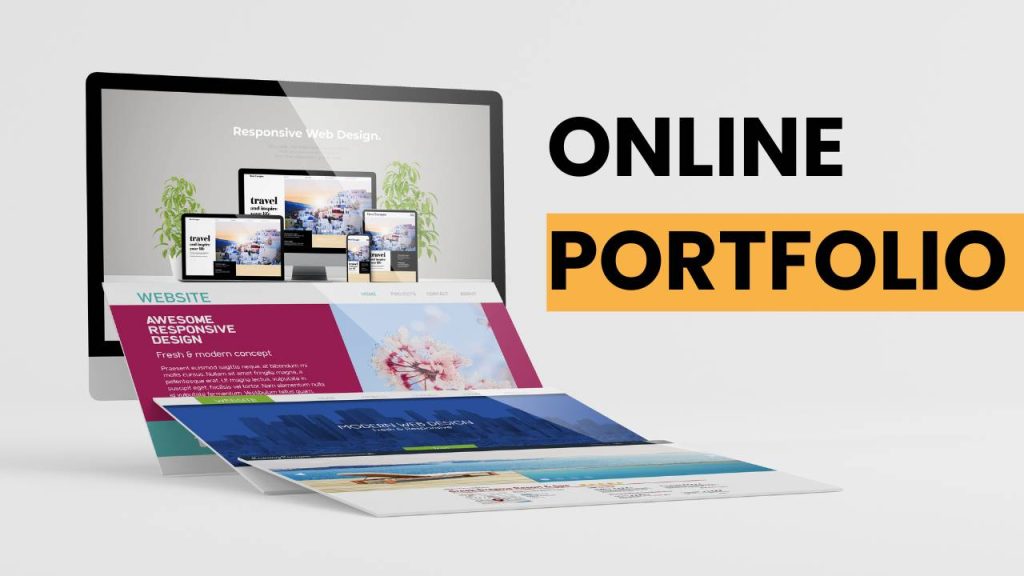Having a well-crafted online portfolio is no longer optional—it’s essential. A designer, developer, writer, or marketer, your online portfolio serves as your professional storefront, showcasing your best work, skills, and personality in a way that a resume simply can’t. A strategically built online portfolio not only reflects your expertise but also speaks directly to potential employers and clients, increasing your chances of landing the job you want.
Best Windows Laptops: Power, Performance & Portability
Know with this article, why an online portfolio is important, the key features it should include, design tips, industry-specific advice, SEO strategies, and common mistakes to avoid. By the end, you’ll have a comprehensive guide to building an online portfolio that gets results.
Why an Online Portfolio is Essential for Job Seekers in 2025
In 2025, employers are no longer solely reliant on traditional resumes to evaluate potential candidates. The job market has shifted to place more emphasis on digital portfolios, which allow hiring managers to see firsthand what you can do rather than just read about it. An online portfolio is not only a place to showcase your work but also a dynamic tool that can set you apart from other candidates.
Having an online portfolio demonstrates several key attributes to employers: professionalism, tech-savviness, and a willingness to embrace modern tools to present your skills. It gives you the opportunity to showcase your best projects, organize your achievements, and include multimedia like images, videos, or interactive elements. In industries like web development, graphic design, or content creation, a polished online portfolio is often expected. It helps establish credibility and allows you to stand out in a crowded market.
Top Features Every Online Portfolio Should Have to Stand Out
To ensure your online portfolio grabs attention in today’s competitive job market, it’s essential to include features that not only showcase your talent but also reflect your professionalism, personality, and value. With that in mind, here are the top elements that can make your portfolio unforgettable and highly effective.
1. Professional Design
To begin with, your online portfolio should have a clean, visually appealing design that reflects your unique style while maintaining a professional look. A thoughtful and intuitive layout allows visitors to navigate seamlessly and focus on your accomplishments without distraction.
In addition, avoid clutter and make strategic use of white space, typography, and brand colors to create a cohesive visual identity. Responsive design is a must—your portfolio should look and function flawlessly on desktops, tablets, and mobile devices. A polished, well-organized site instantly builds trust and sets the tone for your professional brand.
2. About Me Section
Next, this section is more than just a short biography—it’s your opportunity to tell your story and make a memorable first impression. Use this space to highlight your career path, what motivates you professionally, and what differentiates you from others in your field.
Share your passion, your core values, and what inspires your work. Keep it concise, yet rich in personality. A strong About Me section helps potential employers and clients connect with you beyond your resume, which in turn builds an emotional connection that can influence hiring decisions.
3. Showcase of Work
Moving forward, this is the heart of your online portfolio—the place where your talent shines. Be strategic in selecting projects that align with your ideal job or client work. For each piece, include high-quality visuals or samples along with a brief explanation that outlines the project’s objective, your specific role, the tools or technologies used, and the outcomes achieved.
Furthermore, consider incorporating case studies for more complex projects to give viewers a deeper understanding of your creative process and problem-solving skills. Remember, quality always trumps quantity—curate with care.
4. Skills and Expertise
Dedicate a section to clearly list your key skills, technical proficiencies, and any relevant certifications or tools you excel in. Use categories (like “Design Tools,” “Programming Languages,” or “Marketing Platforms”) to keep things organized and easy to scan.
Where appropriate, use skill level indicators or icons for quick visual recognition. This section allows employers to quickly assess whether your expertise matches their needs and can help you show up in search filters if your portfolio is hosted on a platform.
5. Client Testimonials and Recommendations
Another powerful element to include is social proof. Client testimonials, peer reviews, or manager endorsements can significantly boost your credibility. Use direct quotes and always include the full name, title, and company of the person (with their permission, of course).
If possible, add a photo or a link to their LinkedIn profile to further legitimize the testimonial. Even better, a few strong endorsements can make a lasting impression and give hiring managers the reassurance they need to move forward with you.
6. Contact Information and Clear Call to Action
Finally, your online portfolio should make it effortless for potential clients or employers to contact you. Include a dedicated contact section with a professional email address, a contact form, and links to your LinkedIn, social profiles, or other relevant platforms.
Don’t stop there—add a compelling call to action (CTA) such as “Let’s Work Together,” “Book a Free Consultation,” or “Download My Resume.” A strong CTA encourages interaction and guides your visitors on what to do next, which can significantly increase your chances of getting hired.
20 Best Color Schemes for Websites That Wow Users
By incorporating these essential features into your online portfolio, you not only present your qualifications but also tell a compelling story about who you are and why you’re the right choice. In a world where digital presence speaks louder than words, make sure your portfolio leaves a powerful and lasting impression.
How to Design an Online Portfolio That Impresses Employers
Design of your online portfolio plays a important role in shaping how potential employers perceive you. A well-crafted design doesn’t just look good—it speaks volumes about your professionalism, attention to detail, and ability to communicate visually.
A thoughtfully designed portfolio can build instant credibility, show off your personality, and make your work shine. Here’s how to design an online portfolio that leaves a lasting impression and sets you apart from the crowd.
1. Keep It Simple and Clean
Cluttered designs can overwhelm visitors and make it difficult for them to focus on your actual work. Instead, opt for a minimalist layout that emphasizes clarity and organization. Use ample white space to give your content breathing room and create a sense of visual balance. Stick to a limited color palette that aligns with your personal brand, and ensure fonts are legible across all devices.
Consistency in design elements—such as spacing, typography, and visual hierarchy—helps create a smooth user experience and keeps the focus on what matters most: your skills and achievements. Remember, less is often more when it comes to web design.
2. Mobile Optimization
With an increasing number of employers viewing portfolios on mobile devices, responsive design is non-negotiable. Your online portfolio should automatically adapt to various screen sizes, ensuring it looks polished and professional on smartphones, tablets, and desktops alike.
Make sure buttons are easy to tap, text is readable without zooming, and images scale properly. Test your site’s performance across different browsers and devices to guarantee consistency. A mobile-optimized portfolio reflects technical competence and shows that you value accessibility and user experience.
3. Use High-Quality Images and Videos
For creative professionals—such as designers, artists, photographers, or videographers—your visuals are your first impression. That’s why using high-resolution images is essential. Avoid pixelated or low-quality visuals, as they can diminish the impact of your work and appear unprofessional. If including videos—whether for motion graphics, tutorials, or case studies—ensure they are well-edited, have good audio, and load quickly.
Compress your media appropriately so that it doesn’t slow down your site. A crisp visual presentation instantly enhances credibility and allows your talent to shine through clearly.
4. Navigation Should Be Easy
A confusing or complex navigation system can frustrate visitors and prompt them to leave before exploring your work. Your portfolio should be easy to read, with clear menu items and intuitive labels such as “Projects,” “About Me,” “Contact,” and “Resume.” Organize your work into categories if you have multiple disciplines (e.g., graphic design, UX design, branding).
Include a sticky or anchored navigation bar that stays visible as users scroll, enabling them to jump between sections effortlessly. The goal is to make it as easy as possible for potential employers to find exactly what they’re looking for—without clicking through endless pages.
5. Add Personal Branding
Your online portfolio should be more than just a digital resume—it’s a branded experience. Use elements such as a custom logo, signature color palette, and typography that reflect your personality or professional style. Consistency across these elements helps reinforce your identity and makes your site more memorable.
How to Make Your Website Fully Responsive (Step-by-Step Guide)
Include a short personal tagline or mission statement on your homepage that quickly communicates who you are and what you do. For a sleek corporate feel or a bold creative vibe, your branding should align with the types of roles or clients you’re aiming to attract.
Crafting a Winning Online Portfolio: Tips for Different Industries
An effective online portfolio is not one-size-fits-all. Its content, design, and structure should align with your professional goals and speak directly to your target audience. A designer, developer, writer, or marketer, tailoring your portfolio to your industry’s expectations can dramatically increase your chances of landing the right opportunities. Below are detailed tips on how to customize your online portfolio for different industries.
1. For Designers and Artists
A visually stunning portfolio is absolutely essential for professionals in creative fields like graphic design, UI/UX, illustration, or fine arts. First impressions matter here more than anywhere else, so your portfolio’s layout, typography, and color palette should be an extension of your artistic sensibilities.
Showcase a diverse range of projects—logos, branding materials, website designs, packaging, digital illustrations, and more. Each project should include a brief case study, describing your design process, tools used, challenges faced, and final outcomes. Consider using a carousel or grid layout to visually group your work. Above all, make sure the portfolio itself serves as an example of your design capabilities—think of it as your most important project.
2. For Developers
For web developers, software engineers, or app developers, the goal is to showcase your technical proficiency and problem-solving skills. Employers want to see that you can build scalable, functional, and user-friendly applications. Include live demos, screenshots, or screen recordings of your apps or websites, accompanied by direct links to the deployed versions and repositories on GitHub or GitLab.
Each project should include a breakdown of the technologies used (e.g., React, Node.js, Python), your specific contributions, and any notable features or integrations. Consider adding blog posts about solving specific coding challenges, or brief write-ups on how you optimized performance or tackled bugs. This not only showcases your skills but also your ability to communicate complex ideas clearly.
3. For Writers and Content Creators
A writer, editor, journalist, or content strategist, your writing samples are the heart of your online portfolio. Choose a curated mix of pieces that reflect your tone, versatility, and subject matter expertise. These might include blog articles, editorials, website copy, white papers, case studies, email campaigns, or social media content.
Each piece should be accompanied by a brief description—highlight the publication, the intended audience, your objective, and the results if applicable (e.g., engagement metrics, SEO impact). It’s also helpful to organize your content into categories, such as technical writing, lifestyle, marketing, or journalism, so employers can quickly find relevant examples. Bonus points for including downloadable PDFs or links to published content.
4. For Photographers and Videographers
For visual storytellers, the quality and presentation of your work are everything. Your portfolio should be image- and video-centric, allowing your work to speak for itself while still providing important context. Use high-resolution visuals and professionally embedded video players to showcase your talent.
Group your work into categories like weddings, commercial shoots, portrait sessions, travel photography, product photography, or event videography. Each project should include details like camera equipment used, the client’s goals, editing tools, and any creative direction you contributed.
Can also include behind-the-scenes content to give potential clients a glimpse into your process and professionalism on set. Add a pricing guide or contact form for booking inquiries to convert interest into opportunities.
5. For Marketers and Consultants
Professionals in marketing, branding, business strategy, or consulting should focus on outcomes and value delivered to clients or employers. Portfolio should demonstrate how your efforts translated into measurable success. Include detailed case studies with visuals like infographics, charts, or screenshots of campaigns. Break each case study down into: the challenge, your strategy, the execution, and the results (e.g., increased leads, traffic, engagement, or ROI).
In addition to campaign snapshots, consider adding decks, audits, reports, or samples of marketing materials you’ve created. Testimonials from past clients can also boost credibility and trust. Organize your portfolio in a way that highlights your key service areas—such as SEO, PPC, email marketing, branding, or business operations. Clear calls-to-action like “Schedule a Consultation” or “Download My Media Kit” can help move visitors further down your funnel.
How to Make Your Online Portfolio SEO-Friendly for Better Visibility
Having a polished and professional online portfolio is essential, but if no one can find it, it won’t do much for your career. That’s where Search Engine Optimization (SEO) becomes essential. With the right SEO strategies, your portfolio can appear in search results when recruiters, hiring managers, or clients are looking for someone with your exact skill set. Here’s how to make your online portfolio more SEO-friendly and visible online:
1. Use Relevant Keywords
One of the most powerful ways to improve your SEO is by strategically using keywords that your target audience is actively searching for. Start by identifying key terms and phrases relevant to your profession, such as “UI/UX designer in New York,” “freelance content writer,” or “portfolio of full-stack developer.” These keywords should be naturally integrated into your homepage, project descriptions, headings, and even your bio.
Additionally, consider using long-tail keywords, which are more specific phrases that can attract highly targeted traffic. For instance, instead of just using “graphic designer,” try “freelance branding graphic designer for startups.” Tools like Google Keyword Planner or Ubersuggest can help you discover high-volume, low-competition keywords that fit your niche.
2. Optimize Your Images
Images are often the visual highlight of a portfolio, but without proper optimization, they can slow down your site and remain invisible to search engines. Start by giving each image a clear and descriptive file name—something like logo-design-techstartup.png is much better than IMG1234.png.
Next, add alt-text to every image, describing what’s in the image using relevant keywords where appropriate. This not only boosts your SEO but also makes your portfolio more accessible to users with visual impairments. Use image compression tools like TinyPNG or Squoosh to reduce file sizes without losing quality, which helps improve load speed and overall performance.
3. Write a Descriptive Meta Description
Meta description is the snippet of text that appears under your portfolio’s title on search engine results pages. While it doesn’t directly impact rankings, it plays a huge role in encouraging users to click on your site.
Make sure your meta description accurately summarizes who you are and what your portfolio offers. Use active language and include at least one relevant keyword. For example: “Visit the creative web design portfolio of Jane Doe, a San Francisco-based front-end developer specializing in responsive and user-centric designs.”
Keep it between 150–160 characters to ensure it displays correctly in search results.
4. Include Backlinks
Backlinks—links from other reputable websites to your portfolio—are a major ranking factor for SEO. They signal to search engines that your content is valuable and trustworthy. Start by sharing your portfolio on professional platforms like LinkedIn, Behance, GitHub, Dribbble, or Medium. Also, include your portfolio link in your author bios when writing guest posts or contributing to industry blogs.
Can also reach out to past clients or collaborators and ask if they’d be willing to link to your portfolio when showcasing joint work. Another smart move is to participate in online communities and forums related to your niche and include your portfolio in your signature or profile where allowed.
5. Make Your Portfolio Load Fast
Website speed affects both user experience and SEO rankings. If your portfolio takes too long to load, visitors may leave before they even see your work—and Google takes note of that. To keep things running smoothly:
- Compress and properly size all images.
- Minimize the use of unnecessary plugins or scripts.
- Use a reliable hosting provider with good uptime and fast response rates.
- Implement caching to reduce load times for repeat visitors.
- Use tools like Google PageSpeed Insights or GTmetrix to regularly test and optimize your site’s performance.
Fast-loading sites not only improve rankings but also increase the chances that visitors will stay longer and visit more of your work.
Online Portfolio Mistakes to Avoid: What Employers Hate
While a well-crafted online portfolio can open doors and impress hiring managers, a poorly executed one can do the exact opposite. Even the most talented professionals can be overlooked if their portfolio sends the wrong message.
Below are common online portfolio mistakes that could cost you opportunities—and tips on how to avoid them.
1. Overloading Your Portfolio with Too Much Work
Quality over quantity should be your mantra. A portfolio filled with every project you’ve ever done may seem impressive at first glance, but it can overwhelm visitors and make it difficult for them to find your most impactful work. Employers don’t have time to scroll through dozens of similar pieces.
Instead, curate your portfolio by selecting 6–10 of your strongest, most relevant projects. Provide detailed context for each one—what the goals were, the challenges you faced, the tools you used, and the results you achieved. This tells a richer story and helps potential employers quickly assess your skills.
2. Neglecting Mobile Users
In today’s mobile-first world, many recruiters and hiring managers browse portfolios on their phones or tablets. A portfolio that looks amazing on desktop but breaks on mobile can quickly ruin a first impression.
To avoid this mistake, use responsive design to ensure your site adjusts smoothly across screen sizes. Test your portfolio on different devices and browsers, and make sure navigation, images, and text all display properly.
3. Lacking a Clear Call to Action
Even the most visually stunning portfolio won’t convert if there’s no clear direction for what the viewer should do next. Employers should know exactly how to contact you, view your resume, or schedule a meeting—without having to hunt for it.
Make your call to action (CTA) obvious and accessible. Add a “Hire Me,” “Let’s Talk,” or “Download My Resume” button in a prominent spot—like at the top of your homepage and at the end of each project description. Use consistent CTA wording across your site to reinforce the action you want them to take.
4. Forgetting About Grammar and Spelling
Typos, grammar mistakes, and inconsistent formatting are among the quickest ways to lose credibility. If your portfolio has even minor errors, it can signal carelessness—especially in fields like writing, marketing, UX design, or project management where communication is key.
Take the time to proofread every section of your portfolio. Use grammar-checking tools like Grammarly or Hemingway Editor, and, if possible, have someone else review your content for a fresh perspective.
5. Ignoring Analytics
Many creatives focus so much on visuals and content that they forget to measure how their portfolio is performing. Not knowing what’s working and what’s not can lead to missed opportunities and unoptimized content.
Set up Google Analytics (or a similar tool) to track key metrics like page views, bounce rates, time spent on each project, and where your visitors are coming from. This data can help you determine which pieces are attracting the most attention, what devices people are using, and which CTAs are actually converting.
6. Additional Mistake to Avoid: Outdated or Broken Links
Broken links and outdated contact information make it impossible for employers to get in touch with you—and it reflects poorly on your attention to detail. Routinely check your portfolio for functional links, up-to-date social profiles, and accurate contact details.
Top Web Hosting Services Compared (Speed, Price, & Support)
By following these tips, you can create an online portfolio that not only showcases your talents but also increases your chances of landing your dream job.
FAQs
1. What is an online portfolio?
An online portfolio is a digital showcase of your work, skills, and achievements, usually presented through a personal website. It helps professionals present their best work to potential employers or clients in an organized and visually appealing format.
2. Why do I need an online portfolio?
An online portfolio increases your visibility, establishes credibility, and provides a central platform for potential employers or clients to review your qualifications, especially in creative or tech industries. It sets you apart from traditional résumés and helps you stand out in the job market.
3. What should I include in my online portfolio?
Your online portfolio should include an about me section, a showcase of your best work, skills and tools you use, client testimonials or recommendations, contact information, and optionally a blog or case studies.
4. Which platform is best for creating an online portfolio?
Popular platforms include Wix, Squarespace, WordPress, and Behance. Developers might prefer GitHub Pages, while designers often choose Adobe Portfolio. Choose one that aligns with your technical skills and desired style.
5. How do I make my online portfolio stand out?
Use a clean, professional design, tailor your content for your target audience, focus on quality over quantity, and add personal branding elements. Include only your strongest, most relevant work and keep navigation intuitive.
6. Is coding knowledge required to build an online portfolio?
Not necessarily. Platforms like Wix and Squarespace offer drag-and-drop builders that require no coding. Having basic HTML/CSS skills can provide more customization and control over your portfolio design.
7. How do I optimize my online portfolio for SEO?
Use relevant keywords, write descriptive titles and meta tags, add alt text to images, ensure mobile-friendliness, and create backlinks from reputable websites. Also, make sure your site loads quickly and is easy to navigate.
8. How many projects should I include in my portfolio?
Aim for 5–10 high-quality projects that best represent your skills. Each project should include a title, description, your role, tools used, and outcomes. Avoid including outdated or irrelevant work.
9. Can I use my online portfolio as a résumé?
Yes! Many professionals now link to their online portfolio directly from their résumé or job application. Some portfolios even include a downloadable résumé section. Just ensure it’s up to date and professionally presented.
10. How often should I update my online portfolio?
You should update your online portfolio every few months or after completing a major project. Keeping it current ensures that employers always see your latest and most relevant work.




